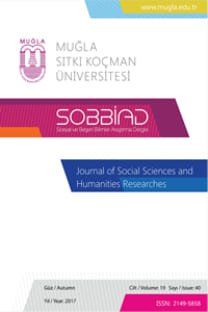ÖZNEL ZİNDELİK ÖLÇEĞİ TÜRKÇE FORMUNUN PSİKOMETRİK ÖZELLİKLERİ
Öznel zindelik, geçerlik, güvenirlik, doğrulayıcı faktör analizi
The Psychometric Properties of Turkish Version of Subjective Vitality Scale
Subjective vitality, validity, reliability, confirmatory factor analysis,
___
- Akın, A. (2012). The relationships between Internet addiction, subjective vitality, and subjective happiness: A structural equation modeling. Cyberpsychology, Behavior and Social Networking, 15, 404–410.
- Akın, A. (2011). Öznel Mutluluk Ölçeğinin Türkçe formunun geçerlik ve güvenirliği. XI. Ulusal Psikolojik Danışma ve Rehberlik Kongresi, 3-5 Ekim, İzmir.
- Bostic, T. J., Rubio, D. M. ve Hood. M. A. (2000). Validation of the subjective vitality scale using structural equation modelling. Social Indicators Research, 52(3), 313–319.
- Büyüköztürk, Ş. (2012). Veri analizi el kitabı. Ankara: PegemA Yayıncılık.
- Büyüköztürk, Ş., Akgün, Ö., Kahveci, Ö. ve Demirel, F. (2004). Güdülenme ve Öğrenme Stratejileri Ölçeği’nin Türkçe formunun geçerlik ve güvenirlik çalışması. Kuram ve Uygulamada Eğitim Bilimleri, 4(2), 207–239.
- Çokluk, Ö., Şekercioğlu, G. ve Büyüköztürk, Ş. (2012). Sosyal bilimler için çok değişkenli istatistik. Ankara: PegemA Yayıncılık.
- Deci, E. L. ve Ryan, R. M. (2000). The ‘what’ and ‘why’ of goal pursuits: Human needs and the self-determination of behavior. Psychological Inquiry, 11, 227–268.
- Erkuş, A. (2012). Psikolojide ölçme ve ölçek geliştirme-I. Ankara: PegemA Yayıncılık.
- Fini, A. A. S., Kavousian, J., Beigy, A. ve Emami, M. ( 2010). Subjective vitality and its anticipating variables on students. Procedia Social and Behavioral Sciences, 5, 150–156.
- Gable, S. L. ve Haidt, J. (2005). What (and why) is positive psychology? Review of General Psychology, 9, 103–110.
- Greenglass, E. R. (2006). Vitality and vigor: Implications for healthy functioning. In P. Buchwald (Ed.), Stress and anxiety application to health, work place, community, and education. Newcastle : Cambridge Scholars Press.
- Hu, L. T. ve Bnetler, P. M. (1999). Cutoff criteria for fit indexes in covariance structural analysis: Conventional criteria versus new alternatives. Structural Equation Modeling, 6, 1–55.
- Jou,, T. H. (1981). The tao of tai-chi chuan. Piscataway, NJ: Tai Chi Foundation
- Jöroskog, K. G. ve Sörbom, D. (1996). Lisrel VI: Analysis of linear structural relationships by maximum likelihood, instrumental variables, and least squares methods. Mooresville, IN: Scientific Software.
- Niemiec, C. P., Lynch, M. F., Vansteenkiste, M., Bernstein, J., Deci, E. L. ve Ryan, R. M. (2006). The antecedents and consequences of autonomous self-regulation for college: A self-determination theory perspective on socialization. Journal of Adolescence, 29, 761–775.
- Nix, R. A., Ryan, R. M., Manly, J. B. ve Decy, E. L. (1999). Revitalization through self-regulation: The effects of autonomous and controlled motivation on happiness and vitality. Journal of Experimental Social Psychology, 35, 266–284.
- Ryan, R. M. ve Frederick C. (1997). On energy, personality and health: Subjective vitality as a dynamic reflection of well-being. Journal of Personality, 65, 529–565.
- Salama–Younes, M. (2011) Positive mental health, subjective vitality, and satisfaction with life for French physical education students. World Journal of Sport Sciences, 4(2), 90–97.
- Seligman, M. E. P. (2002). Authentic happiness. New York: Free Press.
- Seligman, M. E. P., ve Csikszentmihalyi, M. (2000). Positive psychology: An introduction. American Psychologist, 55, 5–14.
- Selye, H. (1956). The stress of life. New York: McGraw-Hill.
- Sümer, N. (2000). Yapısal eşitlik modelleri: Temel kavramlar ve örnek uygulamalar. Türk Psikoloji Yazıları, 3(6), 49–74.
- Şimşek, Ö. F. (2007). Yapısal Eşitlik Modellemesine Giriş: Temel İlkeler ve Lisrel Uygulamaları. Ekinoks Yayınları, Ankara.
- Tabachnick, B. G. ve Fidell, L. S. (2007). Using Multivariate Statistics. Boston: Allyn and Bacon.
- Yılmaz, V. ve Çelik, H. E. (2009). Lisrel ile Yapısal Eşitlik Modellemesi-I: Temel Kavramlar, Uygulamalar, Programlama. Pegem Akademi Yayınları, Ankara
- Wikan, U. (1989). Managing the heart to brighten face and soul: Emotions in Balinese morality and health care. American Ethnologist, 16, 294–312.
- ISSN: 2149-5858
- Yayın Aralığı: Yılda 2 Sayı
- Başlangıç: 2000
- Yayıncı: Mugla Sitki Kocman University
ERZURUMLU İBRAHİM HAKKI’NIN MARİFETNAME’SİNDE ANASIRI-I ERBAA (DÖRT UNSUR) GÖRÜŞÜ
ORTAÇAĞ ANADOLU TİCARET YOLLARI
LİSE SON SINIF ÖĞRENCİLERİNİN SERBEST ZAMAN FAALİYETLERİNE KATILIM BİÇİMLERİNİN DEĞERLENDİRİLMESİ
Yakup Akif Afyon, Mehmet Kırkpınar
MUĞLA SITKI KOÇMAN ÜNİVERSİTESİ SOSYAL BİLİMLER ENSTİTÜSÜ DERGİSİ
KIRGIZ TÜRKÇESİNDE YABANCI DİLLERDEN ALINTILANAN KELİMELERDE SES DÜŞMELERİ
ÇOCUK EDEBİYATINDA “KARAKTER” KAVRAMI
Rebalaıs’nin Gargantua Ve Montaıgne’in Denemeler Eserlerinde Bireycilik
XIX. ve XX. Yüzyılda Osmanlı Latin Amerika İlişkileri
KAZAK EDEBİYATININ DEĞERLİ BİLİM ADAMI: PROF. DR. JANGARA DADEBAYULI (DADEBAYEV)
MUĞLA SITKI KOÇMAN ÜNİVERSİTESİ TIP FAKÜLTESİ ÖĞRENCİLERİNİN DUYGUSAL ZEKA DÜZEYLERİ
Emine Neşe Yeniçeri, Samet GÜLEÇ, Ayşe Seydaoğulları, Ece Yıldız, Ercan BALDEMİR, Selmin Çaylak
